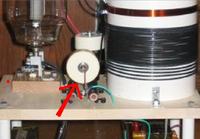FAQ
TL;DR: A well-tuned GU-81M vacuum-tube Tesla coil can throw 24 cm sparks on 4 A input current; “The torus can slightly improve the discharges.” [Elektroda, Anonymous, post #7485813][Elektroda, trzaska456, post #7485596]
Why it matters: This FAQ helps hobbyists squeeze maximum, safe performance from VTTC builds.
Quick Facts
• GU-81M filament: 12.6 V ± 0.6 V, 10–20 A supply recommended [Elektroda, DaKKi, post #7473503][Elektroda, Anonymous, post #7474009]
• Single GU-81M spark length: 20–30 cm when correctly tuned [Elektroda, Anonymous, post #7465698]
• Staccato-controlled coil: up to ~1 m discharges with cycle shortening [Elektroda, Anonymous, post #7483215]
• Typical build cost: PLN 300–350 (≈ €70) including tube, iron, and passives [Elektroda, Anonymous, post #7511231]
• Safe pre-heat: 60 s filament-only before anode power [Tube Data Sheet]
How do I tune a GU-81M VTTC for longer sparks?
- Add 20–40 primary taps. 2. Move the clip until one tap gives the brightest, longest discharge. 3. Adjust grid-to-cathode resistor for peak current. Builders gained 24 cm sparks after removing coils and retapping [Elektroda, trzaska456, post #7485596][Elektroda, lukasb9, post #7474386]
Where should I place the feedback (tuning) winding—above or below the primary?
Both work. Most VTTCs wind the feedback below the secondary to reduce coupling, but some users saw little difference as long as flash-over was avoided [Elektroda, Anonymous, post #7465698][Elektroda, KJ, post #7466106]
What coupling distance between primary and secondary is safe?
Leave at least 2 cm air gap. Increasing spacing from 0.5 cm to 2 cm eliminated arc-over and lengthened sparks in tests [Elektroda, trzaska456, post #7485596]
How much spark length can I expect from one GU-81M tube?
Well-tuned coils reach 30 cm on MOT-based supplies [Elektroda, lukasb9, post #7474386] With a Staccato Controller the same tube can reach ~1 m by pulsing the duty cycle [Elektroda, Anonymous, post #7483215]
What power supply do I need for filament and anode?
Filament: 12.6 V at 10 A minimum; many rewind an SMPS to 12.7 V / 20 A for margin [Elektroda, DaKKi, post #7473503][Elektroda, Anonymous, post #7474009] Anode: one MOT gives ~2 kV; two in series give ~4 kV but draw 7 A, so add series resistors and proper insulation [Elektroda, trzaska456, post #7482070]
Can I run two GU-81M tubes in parallel for more power?
Yes. Wire filaments separately, share a common cathode, and duplicate grid stoppers. Keep the anodes on separate primary halves or a bifilar coil. Expect near-double current draw; upgrade capacitors and transformer accordingly [Elektroda, miernik998, post #7469930]
Do I really need a toroid on a VTTC?
Not mandatory, but a small toroid lowers breakout voltage and stabilises streamers. Users reported a “nice long yellow arc” after adding one [Elektroda, trzaska456, post #7518124] Oversized toroids made tuning harder [Elektroda, Anonymous, post #7477641]
How does a Staccato Controller improve performance?
The CMOS-555 Staccato driver fires the tube at the AC peaks, cutting duty cycle to 10–20 %. Peak anode voltage rises, giving longer sparks without overheating; the Steve Ward design boosted output by ~3× in practice [Elektroda, KJ, post #7469943][Ward, Staccato Controller].
Why does a blue glow appear on the glass envelope?
It’s electron back-scatter hitting the envelope when anode voltage is present without full resonance. This is normal but indicates inefficient operation; retune or add a series resistor [Elektroda, Anonymous, post #7473029]
How long should I heat the filament before applying high voltage?
Wait 60 seconds so the cathode reaches emission temperature; hot-switching shortens tube life [Tube Data Sheet][Elektroda, lodzik1990, post #7863988]
My coil just hums and gives no output—what’s wrong?
Check 3 items: 1) Reverse one feedback lead to correct 180° phase [Elektroda, slu_1982, post #7790795] 2) Look for blown diodes near the MOT [Elektroda, trzaska456, post #7790140] 3) Inspect MMC capacitors—punctured caps kill resonance (common failure) [Elektroda, Anonymous, post #7473029]
Are VTTC sparks safe to touch?
They are lower-current RF discharges; brief contact usually causes mild heating, but continuous arcs can burn skin or ignite flammables [Elektroda, Anonymous, post #7511231] Keep ground connections solid and use insulated tools.
Which capacitors suit the primary resonant tank?
Use polypropylene pulse caps (e.g., CDE 942C series). Russians use HFC 750 pF caps; expect high cost on auction sites [Elektroda, rafixs, post #7472648][Elektroda, Anonymous, post #7477641]
What does reversing a winding lead actually do?
It swaps phase: if the feedback drives the grid 180° out of phase, gain is negative and the coil stalls. Reversing restores positive feedback and oscillation [Elektroda, slu_1982, post #7790795]
How much does a GU-81M VTTC cost to build?
Forum builders spent about PLN 100 on the secondary, PLN 150 on the tube plus heatsink, and another PLN 50 on parts—roughly €70 total [Elektroda, Anonymous, post #7511231]
Edge case: what causes secondary-to-primary punctures?
Too-tight coupling or sharp edges concentrate voltage, leading to flash-over during warm-up [Elektroda, d3211, post #7788619] Increase spacing, round corners, and limit peak current to <8 A.
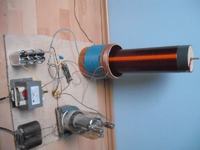 I warmly welcome all fans of high voltage.
I warmly welcome all fans of high voltage.
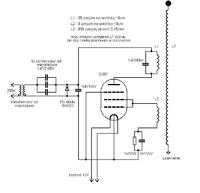

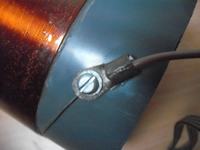
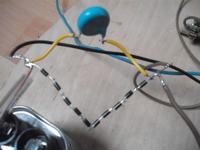
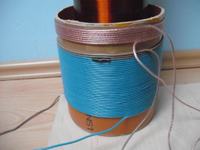

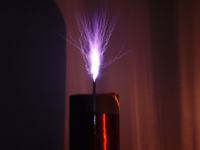
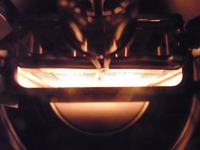





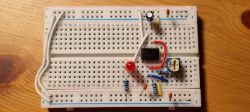

 transformers
transformers 